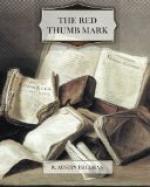“Is there any objection to my using the photograph that I have with me for comparison, my lord?” asked Mr. Singleton.
“I think not,” replied the judge. “What do you say, Mr. Anstey?”
“No objection whatever, my lord,” answered Anstey.
Mr. Singleton accordingly drew from his pocket an enlarged photograph of the thumb-print and a magnifying glass, with the aid of which he explored the bewildering array of prints on the paper before him; and as he proceeded I remarked with satisfaction that his expression became more and more dubious and worried. From time to time he made an entry on a memorandum slip beside him, and, as the entries accumulated, his frown grew deeper and his aspect more puzzled and gloomy.
At length he sat up, and taking the memorandum slip in his hand, addressed the judge.
“I have finished my examination, my lord.”
“Very well. Mr. Nash, will you kindly examine the paper and write down the results of your examination?”
“Oh! I wish they would make haste,” whispered Juliet. “Do you think they will be able to tell the real from the false thumb-prints?”
“I can’t say,” I replied; “but we shall soon know. They looked all alike to me.”
Mr. Nash made his examination with exasperating deliberateness, and preserved throughout an air of stolid attention; but at length he, too, completed his notes and handed the paper back to the usher.
“Now, Mr. Singleton,” said the judge, “let us hear your conclusions. You have been sworn.”
Mr. Singleton stepped into the witness-box, and, laying his notes on the ledge, faced the judge.
“Have you examined the paper that was handed to you?” asked Sir Hector Trumpler.
“I have.”
“What did you see on the paper?”
“I saw twenty thumb-prints, of which some were evident forgeries, some were evidently genuine, and some were doubtful.”
“Taking the thumb-prints seriatim, what have you noted about them?”
Mr. Singleton examined his notes and replied—“The thumb-print on square one is evidently a forgery, as is also number two, though it is a passable imitation. Three and four are genuine; five is an obvious forgery. Six is a genuine thumb-print; seven is a forgery, though a good one; eight is genuine; nine is, I think, a forgery, though it is a remarkably good imitation. Ten and eleven are genuine thumb-marks; twelve and thirteen are forgeries; but as to fourteen I am very doubtful, though I am inclined to regard it as a forgery. Fifteen is genuine, and I think sixteen is also; but I will not swear to it. Seventeen is certainly genuine Eighteen and nineteen I am rather doubtful about, but I am disposed to consider them both forgeries. Twenty is certainly a genuine thumb-print.”
As Mr. Singleton’s evidence proceeded, a look of surprise began to make its appearance on the judge’s face, while the jury glanced from the witness to the notes before them and from their notes to one another in undisguised astonishment.




